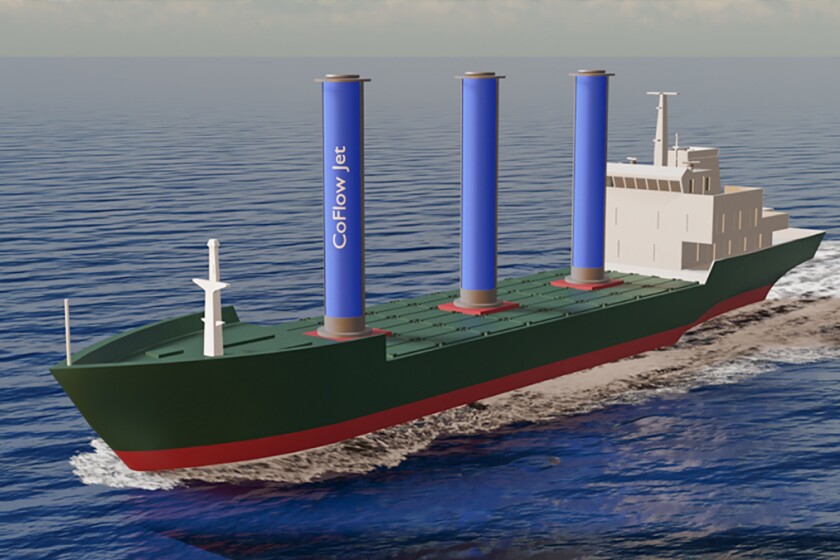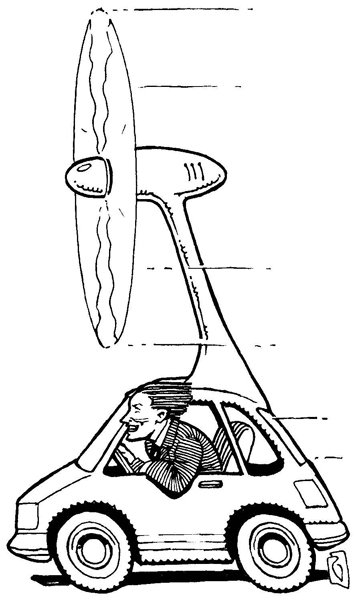
Posted on 08/02/2024 11:16:26 AM PDT by Red Badger

Artist's concept of a ship with the CoFlow system
Looking like a set of bridge supports that were accidentally installed on a cargo ship, a new wind-driven system by startup CoFlow Jet promises to reduce ship fuel costs by up to 90% using stationary cylinders with no moving parts.
Between rising fuel costs and increasing government mandates requiring shipping companies to go carbon neutral by 2050, there's a strong push to increase the efficiency of cargo ships while reducing their emissions. One way of doing this is to take a page from the history books and readopt sails to harness the wind.
On the surface, that makes sense. Sails have been propelling ships all over the world for millennia and were still used for commercial transport until after the Second World War. However, there are two problems with sails that have pushed them out of the cargo market for all except the most local of niches.
First, traditional sails require huge crews. Something the size of the 921-tonne tea clipper Cutty Sark needed a crew of about 30 to handle the sails and the complex sheets and lines that controlled them. Compare that to a modern 196,000-tonne container ship that needs only 13 officers and sailors – and most of them are pushing buttons instead of hauling lines.
The second problem is that sails are completely dependent on the wind. If the wind is blowing hard enough and in the right direction, great. If it's blowing too little or too hard, or if it's blowing from the wrong quarter, that's not so great. If it's not blowing at all, you're not going anywhere.
(Excerpt) Read more at newatlas.com ...
“You do not understand how this operates.”
Obviously not. I asked you to tell me how in your own words but you refused.
Let’s say you’re on this ship and you want to go east and there is a 20mph head wind straight from the east, how will this ship move east? Does it tack? How?
I remember this story. It was in my Weekly Reader in 1976.
If its so efficient, 40 years later, why hasn't it taken over the world?

https://web.archive.org/web/20220401032800/https://www.cousteau.org/legacy/technology/turbosail/
“Obviously not. I asked you to tell me how in your own words but you refused.”
I referred you to their website.
Those are turbosails. Similar but different.
The Magnus Effect is a feature of airflow around a spinning body that is also moving relative to the airstream (or that has air flowing over it). The spinning flow combines with the one-directional flow to produce a net sideways force that, unless balanced out somehow, will push the body to the side.
See "WhoisAlanGreenspan?" fantastic video primer on the subject.
https://freerepublic.com/focus/chat/4255835/posts?page=100#100
“I remember this story. It was in my Weekly Reader in 1976.”
A professional engineer would not make such a statement.
“Let’s say you’re on this ship and you want to go east and there is a 20mph head wind straight from the east, how will this ship move east? Does it tack? How?”
Put on your thinking cap first then read the article.
Good video on Flettner rotors but this one doesn’t rotate.
“ If only you had read the article you would know what you don’t know.”
*************************************************************
Lots of quibbling going on. I have an idea… let the FREE MARKET decide. The FREE MARKET AND FREE ENTERPPRISE are the BEST ALLOCATION OF RESOURCES AND INVESTMENT.
It may simply be that the “juice is not worth the squeeze “. My experience is that ANYTHING that requires the INVOLUNTARY USE OF OTHER-PEOPLE’S-MONEY is usually not economic and allocates money to undeserving purposes. Let the Ocean Carriers decide if they want this.
“That sounds a lot like a perpetual motion machine.”
It “is” as long as the ship keeps moving or the wind blows (there is energy input).
“I remember seeing pictures of these things years ago.”
You THINK you remember. These didn’t exist years ago. Even today, only small test models exist.
Flettner rotors are large rotating cylinders that produce aerodynamic thrust at right angles of the air passing over them. The CoFlow Jet cylinders developed by Zha don't rotate. They draw in a bit of the air from the wind blowing across and through them and then expends it at another part of the cylinder. By drawing in a small amount of air from the intake, pressurizing it using an impeller, and squirting it through the outlet, this generates a pressure imbalance and a considerable amount of thrust, which extends the full length of the cylinders.The only difference is that Zha's rotor sucks air in and then blows out its own wind that curves around the rotor at a the precise point to get the Magnus effect to compel the ship to go forward.
More genius than the Bernoullis, Magnus and the other guys up until now.
The artificial wind is blown around the cylinder at its own quarter as needed.
“The only difference is that Zha’s rotor sucks air in and then blows out its own wind that curves around the rotor at a the precise point to get the Magnus effect to compel the ship to go forward.”
The Flettner spins to produce the pressure difference. This uses a jet of air.
Battery powered aircraft, innovative aerodynamics, Mars rovers, worth a quick look.
Looks like those cylinders are standing right where there are otherwise shipping containers piled high, deep, and wide.
Eliminate the payload for cylinder sails? Great idea!
Did I go and read the whole article? No. The posted picture speaks for itself or should not have been posted in the first place.
“Looks like those cylinders are standing right where there are otherwise shipping containers piled high, deep, and wide.”
Not all ships haul containers.
“Eliminate the payload for cylinder sails? Great idea!”
A large ship may carry 3 million gallons of fuel. You can calculate the volume.
Real world application of Flettner rotors. An older technology but similar profile.


Disclaimer: Opinions posted on Free Republic are those of the individual posters and do not necessarily represent the opinion of Free Republic or its management. All materials posted herein are protected by copyright law and the exemption for fair use of copyrighted works.